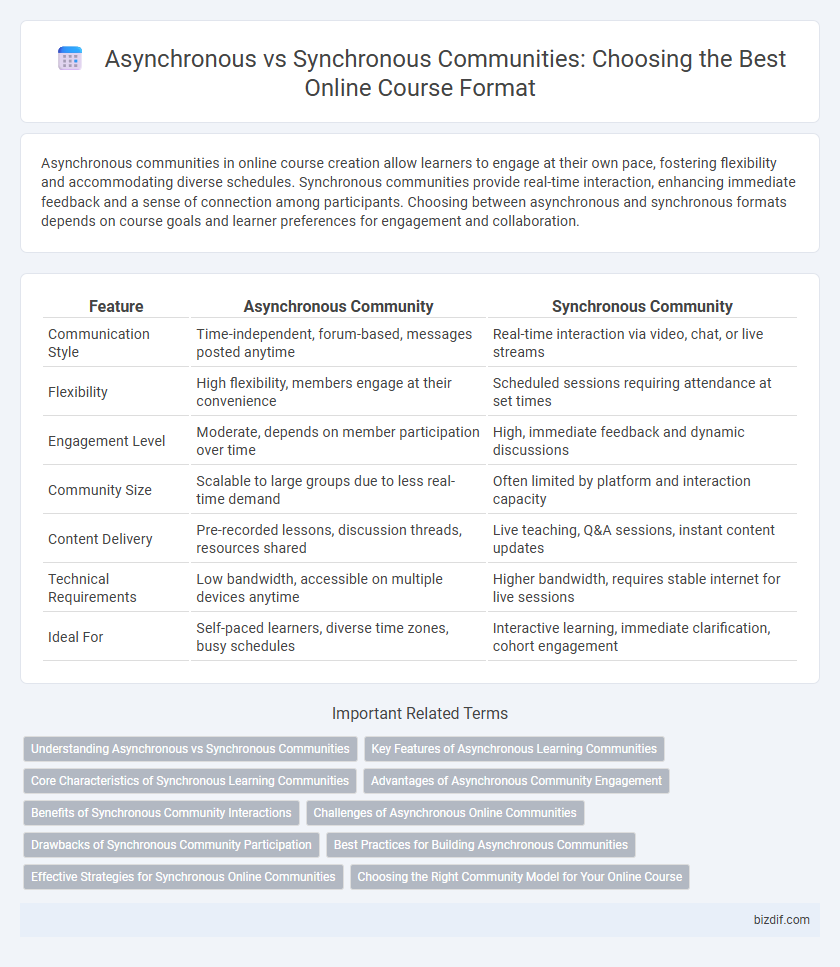Asynchronous communities in online course creation allow learners to engage at their own pace, fostering flexibility and accommodating diverse schedules. Synchronous communities provide real-time interaction, enhancing immediate feedback and a sense of connection among participants. Choosing between asynchronous and synchronous formats depends on course goals and learner preferences for engagement and collaboration.
Table of Comparison
| Feature | Asynchronous Community | Synchronous Community |
|---|---|---|
| Communication Style | Time-independent, forum-based, messages posted anytime | Real-time interaction via video, chat, or live streams |
| Flexibility | High flexibility, members engage at their convenience | Scheduled sessions requiring attendance at set times |
| Engagement Level | Moderate, depends on member participation over time | High, immediate feedback and dynamic discussions |
| Community Size | Scalable to large groups due to less real-time demand | Often limited by platform and interaction capacity |
| Content Delivery | Pre-recorded lessons, discussion threads, resources shared | Live teaching, Q&A sessions, instant content updates |
| Technical Requirements | Low bandwidth, accessible on multiple devices anytime | Higher bandwidth, requires stable internet for live sessions |
| Ideal For | Self-paced learners, diverse time zones, busy schedules | Interactive learning, immediate clarification, cohort engagement |
Understanding Asynchronous vs Synchronous Communities
Asynchronous communities enable learners to engage with course materials and discussions at their own pace, fostering flexibility and deeper reflection without time constraints. Synchronous communities facilitate real-time interaction, promoting immediate feedback and dynamic collaboration through live sessions and video conferencing. Understanding the balance between asynchronous and synchronous elements is crucial for designing online courses that optimize learner engagement and accommodate diverse schedules.
Key Features of Asynchronous Learning Communities
Asynchronous learning communities offer flexible participation, allowing members to engage with course materials and discussions at any time, which supports diverse schedules and time zones. These communities foster deeper reflection and thoughtful responses since learners can take time to formulate their contributions. Key features include discussion forums, self-paced modules, and multimedia resources that enhance collaborative learning without real-time interaction constraints.
Core Characteristics of Synchronous Learning Communities
Synchronous learning communities feature real-time interaction, enabling immediate feedback and dynamic discussions among participants. These communities often rely on live video conferencing, chat rooms, or webinars to facilitate direct engagement and collaboration. Core characteristics include scheduled sessions, active participation, and a sense of presence that enhances motivation and accountability in online course creation.
Advantages of Asynchronous Community Engagement
Asynchronous community engagement in online course creation allows learners to participate at their own pace, enhancing flexibility and accessibility across different time zones. This method fosters deeper reflection and more thoughtful contributions, as participants have time to process information before responding. It also supports diverse schedules, reducing barriers to consistent interaction and increasing overall learner engagement.
Benefits of Synchronous Community Interactions
Synchronous community interactions in online course creation foster real-time engagement, enhancing immediate feedback and dynamic discussions that boost learner motivation and collaboration. These live sessions promote stronger social presence, facilitating clearer communication and deeper understanding through instant clarification of concepts. The interactive nature of synchronous learning environments drives higher retention rates and creates a sense of accountability among participants.
Challenges of Asynchronous Online Communities
Asynchronous online communities often face challenges such as delayed communication, which can hinder real-time feedback and reduce learner engagement in online courses. The lack of immediate interaction may lead to misunderstandings and decreased motivation among students. Effective moderation and structured discussion prompts are essential to maintain active participation and foster a supportive learning environment.
Drawbacks of Synchronous Community Participation
Synchronous community participation in online course creation often leads to scheduling conflicts due to fixed meeting times, limiting flexibility for diverse learner schedules. This real-time interaction can cause increased pressure and anxiety for participants who prefer processing information at their own pace. Limited accessibility for global learners in different time zones reduces overall engagement and inclusivity.
Best Practices for Building Asynchronous Communities
Building asynchronous communities in online course creation involves leveraging discussion boards, message threads, and collaborative documents to facilitate flexible learner interaction. Encouraging timely responses through clear guidelines and regular instructor engagement maintains momentum without the need for real-time presence. Integrating multimedia resources and scheduled check-ins supports diverse learning styles and sustains active participation.
Effective Strategies for Synchronous Online Communities
Effective strategies for synchronous online communities include real-time interaction features such as live chats, video conferencing, and instant polls to boost engagement and participation. Facilitators can enhance learning outcomes by scheduling regular live sessions that encourage active discussions and immediate feedback. Implementing structured activities like breakout rooms and collaborative tasks fosters stronger connections and deeper understanding among participants.
Choosing the Right Community Model for Your Online Course
Choosing the right community model for your online course hinges on your learners' needs and course structure. Asynchronous communities offer flexibility by allowing participants to engage at their own pace, making them ideal for self-paced courses and global audiences across time zones. Synchronous communities foster real-time interaction and immediate feedback, enhancing engagement in live sessions or cohort-based courses where collaboration and instant communication are crucial.
Asynchronous Community vs Synchronous Community Infographic

 bizdif.com
bizdif.com